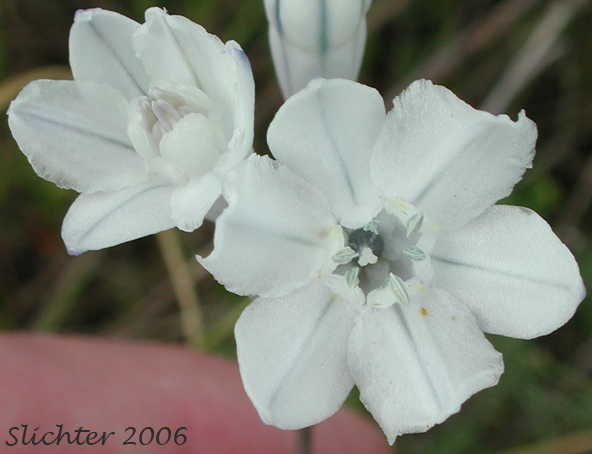 The
photo at right shows a view down onto the tepals of bicolored cluster lily . Note that
the margins of the tepals are only slightly ruffled. Photographed at Memaloose in the central Columbia River Gorge........April 24, 2006.
The
photo at right shows a view down onto the tepals of bicolored cluster lily . Note that
the margins of the tepals are only slightly ruffled. Photographed at Memaloose in the central Columbia River Gorge........April 24, 2006.
Bicolored cluster lily is a pretty prairie wildflower with a single stem arising from 20-70 cm in height from a deep seated, scaly corm. A pair of linear, grass-like leaves arise from the base of the plant. The leaves are flat but keeled beneath, ranging from 25-50 cm long and from 3-10 mm wide.
The inflorescence is a compact umbel, the pedicels ranging from 5-20 mm long. The flowers consist of six fused tepals, forming a tube about 7 to 10 mm long. The tips of the tepals are free. The color of the tepals is white to fairly deep blue, with deeper blue midline stripes running the length of the tepals. Coastal plants may be a deeper blue. Inland plants are much lighter, helping distinguish them from Douglas' Brodiea where their ranges overlap.
The tepals are generally about the same size and are flared equally away from the tube at about the same level. The outer series of tepals are broadly lanceolate in shape without ruffled edges, the inner series oblong or obovate in shape, sometimes with slightly ruffled margins. The anthers range from yellow to light blue and measure from 2.5-3 mm long.
Bicolored cluster lily is very similar in appearance to Douglas' Brodiea. The latter usually has a more open inflorescence with flowers of a deeper blue hue. In addition, the tepals not equal in shape. The inner are broader and with noticeably ruffled margins, the outer tepals oblong-lanceolate without ruffles to slightly ruffled.
The bicolored cluster lily may be found on the grassy bluffs of coastal headlands as well as on arid prairies and among sagebrush at lower elevations.
The bicolored cluster lily is found from southwestern British Columbia south through Puget Sound into the Willamette Valley, westward to the coast, and eastward through the Columbia River Gorge into eastern Washington and Oregon, where it is found at it northernmost in southern Chelan and Grant counties in Washington and at its southernmost in Gilliam County in Oregon.
The bicolored cluster lily may be found through much of the length of the Gorge, ranging from just east of Troutdale, OR east past Biggs Junction. It maybe found there between the elevations of 100'-2500'.